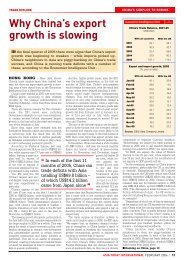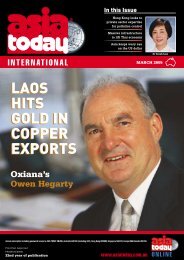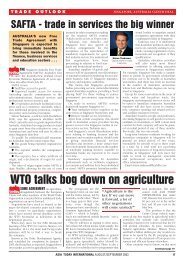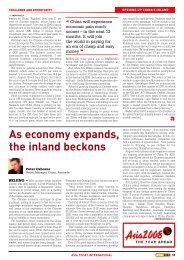d - Asia Today International
d - Asia Today International
d - Asia Today International
Create successful ePaper yourself
Turn your PDF publications into a flip-book with our unique Google optimized e-Paper software.
HIDDEN DANGERS OF A RESOURCES BOOM<br />
➔ FROM PAGE 6<br />
cally and internationally. The Parliament limits<br />
the amount of fund revenue that can be<br />
used by the Government in any one year. The<br />
fund also helps avoid the “Dutch disease”<br />
resulting from excessive government spending<br />
and credit expansion in the short term,<br />
and evens out the revenue ups-and-downs<br />
through volatile oil prices.<br />
Similar funds operate elsewhere in the<br />
world, with the most relevant for Australia in<br />
terms of country and economy comparability<br />
being those in the State of Alaska in the US,<br />
in Alberta, Canada, and in Chile. Elsewhere,<br />
there are funds in Venezuela, Botswana,<br />
Kuwait, Oman, Iran, Azerbaijan and<br />
Kazakhstan. Timor Leste (East Timor), which<br />
recently resolved a problem with Australia<br />
over development of gas fields in the Timor<br />
Sea, is also setting up a fund to manage its oil<br />
and gas revenue. Timor Leste is being<br />
advised by the Norwegian Government.<br />
In the case of a poor country such as Timor<br />
Leste, the fund promises to prevent corruption.<br />
A well-managed fund combined with<br />
careful spending decisions should reduce<br />
Timor’s reliance on overseas government<br />
assistance loans and consequent debt for<br />
health, education and physical infrastructure<br />
development.<br />
Of course, there are plenty of governments<br />
that do manage effectively resource booms<br />
without such funds. This no doubt will be the<br />
argument from most Australian treasuries.<br />
They will also point to the fact that, unlike<br />
classic international cases, mining and petro-<br />
❝ Countries gaining sudden<br />
wealth may find<br />
local manufacturing and<br />
agriculture is squeezed<br />
out by the booming<br />
resources sector as it<br />
causes the currency to<br />
appreciate ❞<br />
leum production is a small proportion of<br />
Australia’s total Gross Domestic Product – not<br />
more than 10 per cent – taking into account<br />
downstream processing and services supply<br />
– and governments rely on many other<br />
sources of revenue apart from resource rents.<br />
But mining and energy (coal, liquefied natural<br />
gas, some oil, and uranium oxide) dominates<br />
Australia’s trading accounts. Mineral<br />
and energy exports made up 39 per cent of<br />
total goods exported in 2004/05. And this figure<br />
underestimates the contribution of natural<br />
resources because it excludes those<br />
exports of minerals partly processed.<br />
Government resource revenue funds in the<br />
Australian situation would most likely have to<br />
be State-based affairs as they levy onshore<br />
and immediate offshore resource royalties,<br />
not Canberra. Canberra does get royalties<br />
from offshore production beyond three nautical<br />
miles, and these will grow sharply with the<br />
assured and large expansion of liquefied natural<br />
gas exports from fields offshore Western<br />
Australia and the Northern Territory. Western<br />
Australia, with vast resources deposits producing<br />
40 per cent of the country’s minerals<br />
and energy, could be a prime candidate.<br />
Mining and petroleum royalties currently contribute<br />
AUD1.3 billion, or about 10 per cent, of<br />
the WA State Government’s AUD13 billion<br />
annual revenue.<br />
Natural resources strike an emotional chord<br />
for the public as they are felt to be national<br />
assets from which all should gain some benefit<br />
as a result of development and export.<br />
Strengthening this feeling will be the probable<br />
growing role of foreign companies and<br />
their investment – and here Australia is likely<br />
to see growing investment from Chinese<br />
companies. Illustrating this, the Chinese<br />
State-owned Sinosteel Corporation recently<br />
dangled US$3 billion in front of Australian iron<br />
ore miners at a conference in Perth. Already<br />
an investor in Australian mines, Sinosteel<br />
said it wanted to partner new projects in<br />
Australia and elsewhere to diversify supply.<br />
As mineral and energy exports rise – a significant<br />
increase is projected by the<br />
Australian Bureau of Agriculture and<br />
Resource Economics – and so play an evergreater<br />
role in Australia’s fortunes, there is<br />
likely to be more public concern over how<br />
governments use their mining and<br />
petroleum revenues.<br />
* Andrew Symon is Singapore<br />
correspondent for ATI.<br />
ASIA TODAY INTERNATIONAL MAY 2006 | 7

















